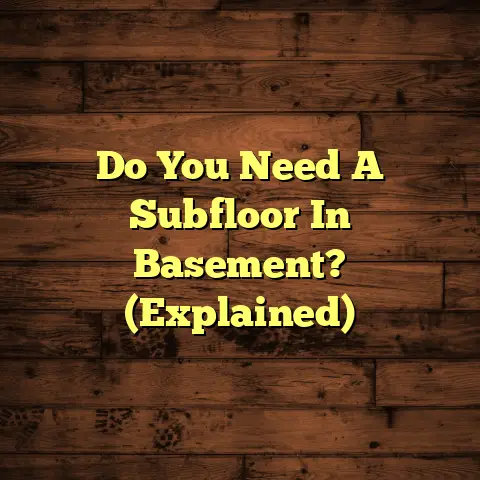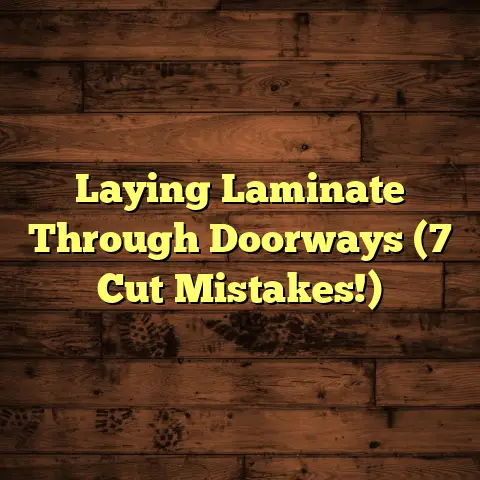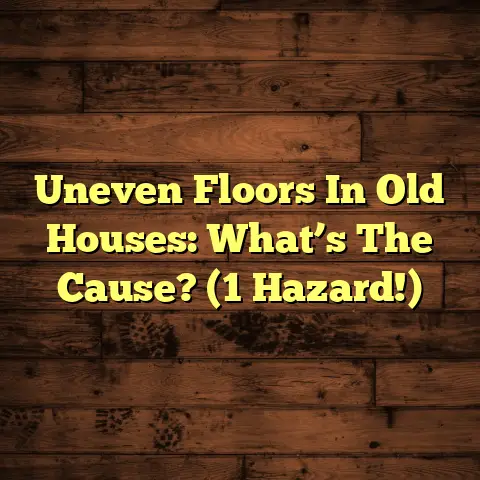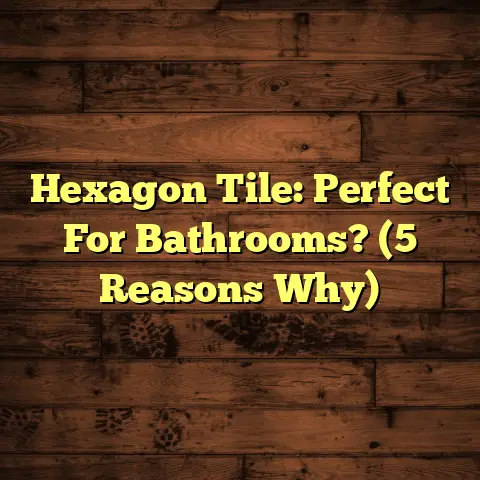Restore Faded Hardwood? (1 Quick Coat!)
I’m excited to share my insights on bringing your tired hardwood floors back to life.
Let’s dive into the world of hardwood restoration, focusing on a simple, effective solution: the one-coat refresh.
Introduction
Modern home design? It’s all about creating spaces that are both stylish and functional.
Flooring is a foundational element.
It sets the stage for everything else.
Hardwood? It’s a timeless choice.
It brings warmth, elegance, and a touch of nature indoors.
From minimalist chic to rustic charm, hardwood complements almost any style.
But let’s face it, life happens.
Sunlight streams in, kids run around, pets do their thing.
Over time, your beautiful hardwood can start to look a little… blah.
Fading, scratches, and dullness creep in.
While a bit of wear and tear can add character, excessive fading just detracts from your home’s overall aesthetic and value.
Think of it like this: your floors are like a good suit.
A little wrinkle here and there? Okay.
But a completely faded, worn-out suit? Not so much.
So, how can you quickly and effectively restore your faded hardwood floors to their former glory with just one coat?
That’s what we’re going to explore.
I’m going to walk you through everything you need to know to bring your hardwood back to life, quickly and easily.
Section 1: Understanding Hardwood Flooring
Hardwood flooring has a rich history.
It dates back centuries.
It started with simple, hand-cut planks.
Over time, milling techniques improved.
This led to more precise and consistent boards.
Today, we have a wide range of hardwood options, from solid wood to engineered wood, each with its own benefits.
-
Solid Hardwood: Classic, durable, can be refinished multiple times.
-
Engineered Hardwood: More stable in humid environments, often less expensive than solid wood.
Let’s talk about the different types of wood.
-
Oak: The most popular choice. It’s known for its durability, distinct grain pattern, and ability to take stain well.
- Red Oak: Has a reddish hue.
- White Oak: More neutral tone.
- Maple: A lighter-colored wood with a fine grain. It’s very durable. It’s a good option for modern spaces.
- Cherry: A rich, reddish-brown wood that darkens with age. It adds warmth and elegance to any room.
What Causes Fading?
Think of your hardwood floors like your skin.
Constant exposure to the sun without protection?
Sunburn and damage.
Same goes for your floors.
Here are the main culprits:
-
Sunlight Exposure: UV rays are the biggest enemy. They break down the finish and cause the wood to bleach.
Think of the areas near windows.
They usually fade the fastest. * Foot Traffic: Constant wear and tear from shoes, especially high heels, can wear down the finish and expose the wood to damage. * Improper Maintenance: Using harsh cleaning products or failing to clean up spills promptly can damage the finish and lead to fading. * Lack of UV Protection: Windows lacking UV film can accelerate fading. * Acidity: Pet urine or acidic spills can damage the finish. * Age: Over time, all finishes degrade. This leaves the wood susceptible to fading.
Maintaining the natural luster and color of your hardwood floors is key to preserving their beauty and value.
According to the National Wood Flooring Association (NWFA), well-maintained hardwood floors can increase a home’s resale value by up to 5%.
Section 2: Signs of Fading and Damage
Okay, so how do you know if your hardwood floors are fading?
Here are some key indicators:
- Discoloration: This is the most obvious sign. You might notice that the areas under rugs or furniture are darker than the exposed areas.
- Dullness: The floor loses its shine and appears flat and lifeless.
- Visible Scratches and Scuffs: These not only look bad but also expose the wood to further damage.
- Changes in Color Intensity: You might see a shift in the overall color of the wood, becoming lighter or more yellowed.
Assessing the Overall Condition
Don’t just focus on the fading.
Take a good look at the entire floor.
- Check for Gaps: Are there gaps between the boards? This can indicate that the wood is drying out or that the subfloor is shifting.
- Look for Cupping or Crowning: These are signs of moisture damage. Cupping is when the edges of the boards are higher than the center. Crowning is the opposite.
- Inspect the Finish: Is the finish peeling, cracking, or chipping? This means it’s time for a refinish.
- Test for Loose Boards: Walk around and listen for squeaks or creaks. Loose boards can be a tripping hazard.
Environmental Factors
Your home’s environment can have a big impact on your hardwood floors.
- Humidity: High humidity can cause the wood to swell, while low humidity can cause it to shrink. This can lead to gaps, cupping, or crowning.
- Temperature: Extreme temperature changes can also stress the wood.
- Sunlight: As we discussed, sunlight is a major cause of fading.
Observing Changes Over Time
The best way to catch fading early is to pay attention to your floors.
Take photos periodically.
Compare them over time.
This will help you notice subtle changes that you might otherwise miss.
I usually recommend doing this every 6 months.
If you notice any of these signs, it’s time to consider restoration.
But don’t worry, it doesn’t have to be a huge, expensive project.
That’s where the one-coat solution comes in.
Section 3: The One Quick Coat Solution
Okay, let’s talk about the star of the show: the one-coat restoration product.
These products are designed to revitalize faded hardwood floors quickly and easily.
They’re a great alternative to traditional refinishing, which can be time-consuming, messy, and expensive.
Benefits of a One-Coat Solution
- Ease of Application: Most one-coat products are designed for DIYers. They’re easy to apply with a mop, pad, or brush.
- Time Efficiency: You can usually complete the project in a single day.
- Cost-Effectiveness: One-coat products are significantly cheaper than hiring a professional to refinish your floors.
- Minimal Disruption: Unlike traditional refinishing, there’s no need to move out of your house or deal with heavy sanding equipment.
Types of Products Available
There are several types of one-coat restoration products on the market.
- Stain and Finish Combinations: These products add color and protection in one step. They’re a good option if you want to change the color of your floors or deepen the existing color.
- Polyurethane Refreshers: These products add a clear coat of polyurethane to restore the shine and protect the floor from further damage. They’re a good option if you like the existing color of your floors and just want to refresh the finish.
- Oil-Based Refreshers: These products penetrate the wood to nourish and protect it. They’re a good option for older floors that are dry and brittle.
- Acrylic Refreshers: These are water- based products which are less toxic and dry faster than oil-based refreshers.
Choosing the Right Product
The best product for you will depend on the type of hardwood you have, the degree of fading, and your desired outcome.
Here’s a quick guide:
- For Lightly Faded Floors: A polyurethane refresher or an oil-based refresher may be all you need.
- For Moderately Faded Floors: A stain and finish combination can help restore the color and add protection.
- For Heavily Faded Floors: You may need to sand the floors lightly before applying a stain and finish combination.
Always read the product label carefully and follow the manufacturer’s instructions.
Preparing the Floor
Proper preparation is key to a successful one-coat restoration.
-
Cleaning: Start by thoroughly cleaning the floor with a hardwood floor cleaner. Remove any dirt, dust, and debris.
- I recommend using a pH-neutral cleaner.
-
Sanding (If Necessary): If the floor is heavily faded or has a lot of scratches, you may need to sand it lightly with fine-grit sandpaper.
-
This will help the new finish adhere better.
- Be sure to vacuum up all the sanding dust before proceeding.
- Tack Cloth: Wipe the floor with a tack cloth to remove any remaining dust.
- Test Area: Before applying the product to the entire floor, test it in an inconspicuous area to make sure you like the color and finish.
Section 4: Application Process
Alright, let’s get down to business.
Here’s a step-by-step guide to applying your one-coat restoration product:
-
Gather Your Supplies: You’ll need:
- The one-coat restoration product
- A mop, pad, or brush (depending on the product)
- A paint tray (if using a brush or roller)
- Painter’s tape
- Rags
- Safety glasses
- Gloves
- Protect the Area: Use painter’s tape to protect baseboards, walls, and other surfaces.
-
Apply the Product: Pour a small amount of the product into the paint tray. Dip the mop, pad, or brush into the product and apply it to the floor in thin, even coats.
-
Work in small sections.
- Follow the grain of the wood.
- Avoid applying too much product, as this can lead to streaks or bubbles.
- Maintain a Wet Edge: Overlap each section slightly to ensure a seamless finish.
- Allow to Dry: Let the product dry completely according to the manufacturer’s instructions. This may take several hours or even overnight.
- Apply a Second Coat (If Desired): Some products recommend applying a second coat for added protection and durability. If so, repeat steps 3-5.
- Remove Painter’s Tape: Once the floor is completely dry, carefully remove the painter’s tape.
Tips for an Even Finish
- Use a High-Quality Applicator: A good mop, pad, or brush will help you achieve a smooth, even finish.
- Apply Thin Coats: Multiple thin coats are better than one thick coat.
- Work in Good Lighting: Make sure you have plenty of light so you can see what you’re doing.
- Don’t Rush: Take your time and pay attention to detail.
Common Pitfalls to Avoid
- Applying Too Much Product: This can lead to streaks, bubbles, and uneven drying.
- Not Preparing the Floor Properly: A dirty or dusty floor will prevent the product from adhering properly.
- Walking on the Floor Before It’s Dry: This will leave footprints and ruin the finish.
- Using the Wrong Product: Make sure you choose a product that is compatible with your type of hardwood and the existing finish.
Following Manufacturer Instructions
I can’t stress this enough: always read and follow the manufacturer’s instructions.
They know their product best.
They’ll provide specific guidance on application techniques, drying times, and safety precautions.
Section 5: Maintenance After Restoration
Okay, you’ve restored your faded hardwood floors.
Now, how do you keep them looking great for years to come?
Here are some essential maintenance tips:
-
Regular Cleaning: Sweep or vacuum your floors regularly to remove dirt and debris. Use a hardwood floor cleaner to mop the floors as needed.
- Avoid using harsh chemicals or abrasive cleaners.
- Use Rugs: Place rugs in high-traffic areas, such as hallways and entryways, to protect the floor from wear and tear.
- Minimize Direct Sunlight Exposure: Use curtains, blinds, or UV-blocking window film to reduce the amount of sunlight that reaches your floors.
- Choose Appropriate Footwear: Avoid wearing high heels or shoes with cleats indoors.
- Use Furniture Pads: Place felt pads under the legs of furniture to prevent scratches and dents.
- Clean Up Spills Promptly: Wipe up spills immediately to prevent staining or water damage.
- Control Humidity: Use a humidifier or dehumidifier to maintain a consistent humidity level in your home.
Routine Inspections
Inspect your floors regularly for signs of wear and tear.
Look for scratches, scuffs, and areas where the finish is wearing thin.
Address these issues promptly to prevent them from becoming bigger problems.
Preventative Measures
- Apply a Protective Coating: Consider applying a protective coating, such as polyurethane, to extend the life of your floors.
- Reapply the One-Coat Product: Depending on the product and the amount of traffic your floors receive, you may need to reapply the one-coat product every few years.
Conclusion
Maintaining the beauty of your hardwood floors is essential for creating a stylish and inviting home.
A simple one-coat solution can revitalize faded hardwood, bringing life back to your interior.
Don’t let faded floors drag down your home’s aesthetic.
Take pride in your flooring.
Remember, with the right care and attention, your hardwood floors can remain stunning and functional for years to come.
Restoring faded hardwood doesn’t have to be a daunting task.
With one quick coat, you can reclaim the beauty of your floors and enjoy a refreshed, revitalized living space.
So, go ahead, give it a try!
I’m confident that you’ll be amazed at the results.
Happy restoring!





